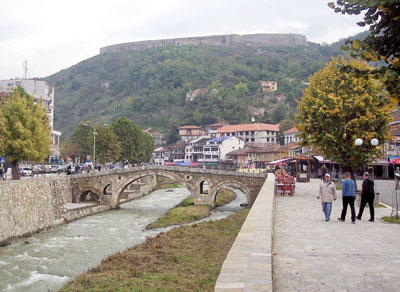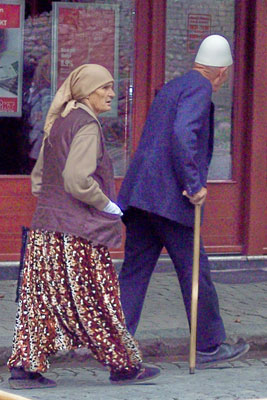Kosovo rising
This item appears on page 69 of the February 2011 issue.
(part 1 of 2 on Kosovo & Albania)
Is the tiny country of Kosovo in the Balkans a viable tourist destination for Americans? This was the question on my mind as I traveled to the world’s newest country, separated from Serbia only in 2008, as a guest of the American Tourism Society (ATS). ATS had invited me to attend their annual conference, being held in Pristina, Kosovo, in late October 2010.
ATS is an organization of tourism professionals representing all facets of the tourism industry. Its primary purpose is to assist developing countries with tourism education and promotion.
The conference was held on the small but lively campus of the American University of Kosovo. I was one of three journalists scheduled to attend the conference one day, then spend another five days touring Kosovo and two additional days in neighboring Albania.
The Kosovo equation is complicated
The soul of Kosovo is still recovering from the horrors of a genocidal campaign waged by Serbian forces under Slobodan Milosevic against the majority Albanian Muslim population little more than a decade ago.
Under the weight of the challenges of newfound nationhood, Kosovo’s politics and economy remain in disarray, with an unemployment rate too high to accurately measure. The country plans to complete a census soon, which will provide more accurate information for future planning.
In spite of the negatives, the people and especially the youth of Kosovo are vibrant, positive and unrelentingly optimistic. Despite the financial hardships currently experienced by the majority of the population, the crime rate is relatively low, and visitors are safe walking in the cities day and night. A major plus — Americans are loved in both Kosovo and neighboring Albania for past assistance provided.
Pristina
Our eight-night itinerary had us based in the capital, Pristina (pop. 500,000-plus), for four nights. From there, we made side trips to regional attractions.
In the 1950s Pristina was essentially disassembled by the Communists, who then reconstructed a city composed of styleless, unattractive buildings. Modern-day Pristina, therefore, is somewhat lacking in visual appeal and tourist attractions.
Our morning walking tour of Pristina included the gaudy public library, the National Museum and the statues of Mother Teresa, Bill Clinton and 15th-century Albanian military hero George Scanderbeg.
Travelers to this region of the Balkans who are visiting multiple countries and have limited time in Kosovo may wish to consider bypassing Pristina in favor of other destinations.
For those who are accommodating in Pristina, I recommend two smaller hotels: Hotel Royal (Pashko Vasa, No. 3; phone 381 38 220 902), at $130, double, and Hotel Ambassador (Str. Ardian Krasniqi, Nr 1; phone 381 38 248 300), at $150, double, including breakfast and mini-bar drinks.
Battle of Kosovo
On our first morning, our group had the good fortune to be taken on a tour by British journalist Nick Wood, a former New York Times and BBC reporter and an expert on Kosovo and the Balkans. He operates a fascinating new tour company, Political Tours.
We began with a sobering visit to the site of the 1389 Battle of Kosovo, which resulted in the Ottomans’ being able to expand their empire. A viewing tower we climbed provided perspective regarding the expansiveness of the three-day battle.
The site was also a rallying point for Serbian nationalism in the late 1980s, hosting a polarizing speech by the dictator Milosevic just before he began his campaign of terror in the region.
Next we visited the serene grounds of the tomb of Sultan Murat, a slain hero of the Battle of Kosovo. Descendants of the sultan have maintained the tomb site for over six centuries, hosting thousands of visitors. A mulberry tree reported to be 700 years old accents the attractive grounds.
Mitrovica awakenings
We continued on to Mitrovica, a rather polluted industrial city that best presents the tense political realities of Kosovo today.
The city is divided into two parts, separated by a bridge that is patrolled by UN soldiers (on our crossing, Italians and Greeks). On one side is the majority Albanian Muslim population and on the other, a Serbian Orthodox population whose loyalties remain more to Serbia than Kosovo.
Nick had arranged for us to have lunch on the Serbian side with a friend, Tatjana, a Serbian teacher who had attended university in Pristina. We had to park and present credentials to the UN soldiers before being allowed to walk across the bridge.
Tatjana strongly presented the Serb side of the ongoing conflict and assisted in making it clear just how intricate the political situation remains. It is complicated by the fact that some of the most important traditional Serbian Orthodox sites are now within the borders of newly created Kosovo. When asked point blank, she admitted she considered her capital to be Belgrade, not Pristina.
On a much-needed lighter note, at lunch I discovered the Serbian beer Jelen, which was the best I sampled on the trip.
Into the clouds
After lunch, we hiked in the mountains behind the city to clear our minds of the heady conversation and explore the fairly recently discovered and now partially excavated ruins of St. Demetrius Church. The exact years of its origins are undocumented, but it is believed to have been built in the 12th century. Excavations at this important archaeological site have unearthed many frescoes.
On our return to Pristina at sunset, we visited the Sultan Mehmet al-Fatih Mosque (1460-1461) in the Old Quarter — a fitting end to a mind-boggling day.
Prizren
Two visits to the quaint city of Prizren provided opportunities to hike to the summit of old castle ruins and visit a fine ethnological museum.
A picturesque stream meanders alongside the Old Quarter’s pedestrian-only shopping district, and the nightlife scene there is among the best in Kosovo.
With some infrastructure improvements, it has definite potential as a destination for international visitors.
Kosovo information
I recommend consulting the following sources for tourism information concerning Kosovo: Kosovo Guide; Kosovo Tourism Group (phone 381 [0] 38 220 201) and Political Tours (phone 44 7855 266 151, e-mail nicholaswood@politicaltours.com).
Next month I will report on Peja, Kosovo, and Tirana, Albania.
Keck's Beyond the Garden Wall
❝ To see through the eyes of the other
To feel their joys with exclamation, their sorrows with anguish
To know the other, we must find and celebrate the common humanity
This simple truth is the only path to peace in the realm ❞
— Randy on the plight of Kosovo and lands beyond


